
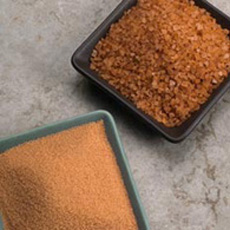
Alaea Sea Salt is a traditional Hawaiian table salt used to season and preserve. Alaea is a natural mineral volcanic baked red clay, added to enrich the salt with iron oxide. Photo courtesy of Saltworks.us, a wonderful resource for many types of gourmet salts. See our Salt Glossary for more sea salts.
June 2006
Updated November 2008
|
 |
Product Reviews / Main Nibbles / Seasonings
A Brief History of Salt
Page 4: Sea Salt
This is Page 4 of a four-page article. Click on the black links below to visit other pages.
Splendid Sea Salt
Growing up, most of us were familiar with table salt and perhaps kosher salt for cooking (margarita salt is simply a coarse grind of salt, like kosher salt). If you made ice cream at home with an older-style machine, you used rock salt. Ten years ago, few people in America beyond French chefs had heard of sea salt; those who did were educated though European travel or French cooking.
Today, sea salt is perhaps one of the biggest national gourmet obsessions since balsamic vinegar. Led by a new generation of American chefs who have been using it in dishes sweet and savory and as a garnish on everything from heirloom tomatoes to desserts and petit fours (read our article on salt caramels), it’s a logical evolution. After all, the classic margarita juxtaposes sweet Triple Sec with a salty rim; and fruity margaritas add that much more sugar to contrast with the salt.
These days, a restaurant worth its salt will have a cellar of sea salt on the table: no 20th century salt shaker will do. Each sea salt has a distinctive taste and texture, based on trace mineral content, crystal shape and size. The complex salt flavors and textures, so different from common table salt, add a distinctive dimension to food, actually acting as a condiment (and some salts are so beautiful, they serve as a garnish as well—a sprinkling on the food or on the plate enhances the beauty of the presentation).
 With so many salts and so little time, we predict the coming of a “salt of the month” approach at fine dining establishments: “Good evening madame. This month’s salt is Anglesey, harvested from the Atlantic waters that surround the Isle of Anglesey, off the west coast of Wales. Anglesey has a soft, flaky texture. Why not begin your tasting by sprinkling some on the butter with your bread?” With so many salts and so little time, we predict the coming of a “salt of the month” approach at fine dining establishments: “Good evening madame. This month’s salt is Anglesey, harvested from the Atlantic waters that surround the Isle of Anglesey, off the west coast of Wales. Anglesey has a soft, flaky texture. Why not begin your tasting by sprinkling some on the butter with your bread?”
Salt & Umami
Salt is one of the four or five flavors which human taste buds recognize. You know about sweet, sour, salty and bitter; the fifth flavor, umami or “savoriness,” focuses on a “brothy” taste equating to the taste of the common food flavoring monosodium glutamate, or MSG. A concept considered basic in Japanese and Chinese cuisine, it was recently explained to Westerners in a scientific-yet-entertaining book with great recipes so you can fully understand the concept: The Fifth Taste: Cooking with Umami, by Anna Kasabian and David Kasabian (photo above). Read our article about umami. You’ll learn to recognize umami not only in fermented Asian foods such as soy sauce, fish sauce, miso and black bean sauce; but in some vegetables, soup stocks, anchovies, parmesan and Roquefort cheeses, tomatoes, (including tomato sauce and ketchup), walnuts, grapes, broccoli, mushrooms, and to a lesser degree in meat (although sometimes the umami flavor is referred to as “meaty”).
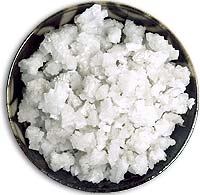 Sea Salt (also called sal del mar [Portuguese], sel de mer [French], and sale marino [Italian]). Sea salt is a broad term that refers to unrefined salt derived directly from a living ocean or sea. It is harvested by channeling ocean water into large, shallow clay trays or other receptacles and allowing the sun and wind to evaporate it naturally. The finest artisan salts are natural or organic and are not treated or washed. Even lesser-grade sea salts are typically not refined as much as other kinds of salt, so they still contain traces of other minerals, including iron, magnesium, calcium, potassium, manganese, zinc and iodine. While all table salts are sodium chloride, there is a night-and-day difference between the flavor of sea salts, which are an artisan product, and common table salt. Because different bodies of water have different mineral contents, salts will look and taste different: some have flowery nuances, some are strong, some delicate, some have sulfuric notes, some can taste sweet, et al. For the convenience of chefs and consumers, sea salt is produced in coarse, fine and extra fine grain sizes. Since there are different qualities of sea salt, for a finishing salt or garnish, buy the best. A little lasts a long time, and you’ll taste the difference. Sea Salt (also called sal del mar [Portuguese], sel de mer [French], and sale marino [Italian]). Sea salt is a broad term that refers to unrefined salt derived directly from a living ocean or sea. It is harvested by channeling ocean water into large, shallow clay trays or other receptacles and allowing the sun and wind to evaporate it naturally. The finest artisan salts are natural or organic and are not treated or washed. Even lesser-grade sea salts are typically not refined as much as other kinds of salt, so they still contain traces of other minerals, including iron, magnesium, calcium, potassium, manganese, zinc and iodine. While all table salts are sodium chloride, there is a night-and-day difference between the flavor of sea salts, which are an artisan product, and common table salt. Because different bodies of water have different mineral contents, salts will look and taste different: some have flowery nuances, some are strong, some delicate, some have sulfuric notes, some can taste sweet, et al. For the convenience of chefs and consumers, sea salt is produced in coarse, fine and extra fine grain sizes. Since there are different qualities of sea salt, for a finishing salt or garnish, buy the best. A little lasts a long time, and you’ll taste the difference. 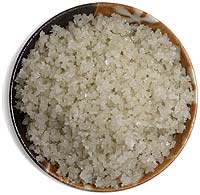 Grey Sea Salt (also called grey salt, Celtic sea salt and sel gris [French]). Grey sea salt is a “moist,” unrefined sea salt harvested along the coastal areas of France. Its light grey color sometimes has a purplish hue, depending on the amount of clay found in the salt flats. One of the most famous salt ponds, in the salt marshes around the town of Guérande in Brittany, France, is lined with natural clay and produces very grey salts. The clay contributes valuable minerals and nutrients that add to both the nutritional value and flavor of the salts. Grey salt is collected by hand with wooden rakes by artisan paludiers (salt harvesters or salt rakers) who sweep the top of the evaporating sea water (this is an ancient Celtic method which earns the salt its name). For centuries a mainstay of French cooking, grey salt has gained great popularity in the mainstream culinary world over the last few years and is considered by many to be the best quality salt available. Fleur de Sel is a particular kind of grey salt. Grey Sea Salt (also called grey salt, Celtic sea salt and sel gris [French]). Grey sea salt is a “moist,” unrefined sea salt harvested along the coastal areas of France. Its light grey color sometimes has a purplish hue, depending on the amount of clay found in the salt flats. One of the most famous salt ponds, in the salt marshes around the town of Guérande in Brittany, France, is lined with natural clay and produces very grey salts. The clay contributes valuable minerals and nutrients that add to both the nutritional value and flavor of the salts. Grey salt is collected by hand with wooden rakes by artisan paludiers (salt harvesters or salt rakers) who sweep the top of the evaporating sea water (this is an ancient Celtic method which earns the salt its name). For centuries a mainstay of French cooking, grey salt has gained great popularity in the mainstream culinary world over the last few years and is considered by many to be the best quality salt available. Fleur de Sel is a particular kind of grey salt. 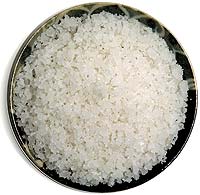 Fleur de Sel (also called flower of salt, flor de sal [Portuguese]). The name comes from the aroma of violets that develops as the salt dries. Perhaps the best known artisan sea salt, it is comprised of “young” crystals that form naturally on the surface of salt evaporation ponds—only the premium, top layer of the salt bed is used. French Fleur de Sel is hand-harvested by paludiers under specific weather conditions, on especially warm days that abet the evaporation of the salt crust on the surface of the salt pool. It is choice, less salty and more delicate than sel gris as a whole. Like wine regions, different areas produce salts with their own unique flavor and aroma profiles. The Guérande region of Brittany, which produces grey sea salt, produces a fine Fleur de Sel de Guérande. Fleur de Sel de Camargue, from the Mediterranean salt marshes of Camargue in Provence, is also highly respected. Fleur de Sel is the favorite of many chefs to season salads, cooked fresh vegetables and grilled meats; as well as for chocolates and other dessert applications. Fleur de Sel (also called flower of salt, flor de sal [Portuguese]). The name comes from the aroma of violets that develops as the salt dries. Perhaps the best known artisan sea salt, it is comprised of “young” crystals that form naturally on the surface of salt evaporation ponds—only the premium, top layer of the salt bed is used. French Fleur de Sel is hand-harvested by paludiers under specific weather conditions, on especially warm days that abet the evaporation of the salt crust on the surface of the salt pool. It is choice, less salty and more delicate than sel gris as a whole. Like wine regions, different areas produce salts with their own unique flavor and aroma profiles. The Guérande region of Brittany, which produces grey sea salt, produces a fine Fleur de Sel de Guérande. Fleur de Sel de Camargue, from the Mediterranean salt marshes of Camargue in Provence, is also highly respected. Fleur de Sel is the favorite of many chefs to season salads, cooked fresh vegetables and grilled meats; as well as for chocolates and other dessert applications.
The photos above are courtesy of Saltworks.us.
For A Major Review Of Sea Salt & Artisan Salt, Visit Our Salt Glossary
Go To The Article Index Above
Favorite Salts From Around The World
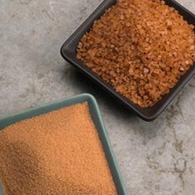 |
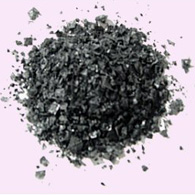 |
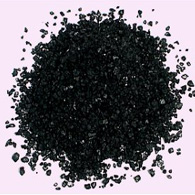 |
Alaea Hawaiian Sea Salt. Alaea is the traditional Hawaiian table salt used to season and preserve. It is rich in trace minerals, all of which are found in sea water. A small amount of harvested reddish Hawaiian clay (alaea) enriches the salt with iron-oxide. Click here to purchase or for more information. |
Black Cyprus Flake Sea Salt. A distinctive, flaky pyramid-shaped salt that stimulates the imagination. Garnish hors d’oeuvres; chicken and veal; white fish, arctic char and other seafood; tomatoes and other vegetables; eggs and much more. The beauty and drama of the salt as well as the delicate flavor makes an everyday dish into a gourmet presentation. Click here to purchase or for more information.
|
Hawaiian Black Lava Sea Salt. Although less well known than the traditional red alaea salt, hawaiian black sea salt, or lava salt, is a dramatic, glossy black sea salt with a sulfur nose. The unique color comes from lava, which adds minerals and activated charcoal, resulting in a sulfuric aroma. Delicious on all seafoods; use as a finishing salt. Like the red salt, a dramatic garnish and plate decor. Click here to purchase or for more information. |
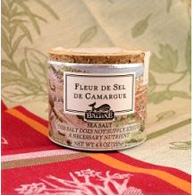 |
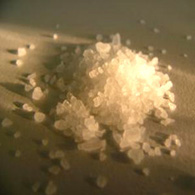 |
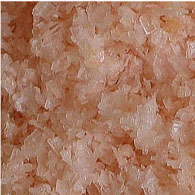 |
Fleur de Sel de Camargue. Hand gathered from the Mediterranean salt marshes in the Camargue region of Provence, France and carefully dried without processing or refining, this sea salt is a favorite of connoisseurs around the world. The container has a cork top and is labeled with the salt harvester’s name (as each harvest is considered a unique art form). Fleur de Sel is wonderful atop meats, potatoes and poultry; sprinkle it atop your favorite foods just prior to serving. Click here to purchase or for more information. |
Maldon Sea Salt. From the banks of the River Blackwater in Essex, England, Maldon is known for its pyramid-shaped crystals, soft texture and delicate, clean taste. It is the ideal complement to meat in flavor and in forming the desirable crust on seared cuts. Maldon often wins taste tests over Fleur de Sel and other sea salts. When it won in a Cook’s Illustrated test, “Tasters loved the crunch of the large sea-salt flakes or crystals when sprinkled over slices of roast tenderloin.” Click here to purchase or for more information. |
Murray River Pink Flake Sea Salt. This pink flake salt is from the Murray River, the largest river in Australia. It empties into the Murray Darling Basin, where low rainfall leads to a high concentration of salinity. The delicate flakes dissolve quickly on food. As a finishing salt, it is well suited for beef and game. Click here to purchase or for more information. |
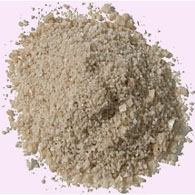 |
|
|
Smoked Fleur de Sel. It’s rare to find a naturally smoked Fleur de Sel de Guérande. After harvesting, the salt is smoked over the wood of select French oak wine barrels that were used to age French chardonnay wine. During smoking, the Fleur de Sel turns a pale brown and absorbs the complex flavor combination of smoke, oak and chardonnay. An exceptional finishing salt for meats, seafood, pasta, salads and eggs. 6. Click here to purchase or for more information. |
|
|
Lifestyle Direct, Inc. All rights reserved. Images are the copyright of their respective owners.

|








 Fleur de Sel (also called flower of salt, flor de sal [Portuguese]). The name comes from the aroma of violets that develops as the salt dries. Perhaps the best known artisan sea salt, it is comprised of “young” crystals that form naturally on the surface of salt evaporation ponds—only the premium, top layer of the salt bed is used. French Fleur de Sel is hand-harvested by paludiers under specific weather conditions, on especially warm days that abet the evaporation of the salt crust on the surface of the salt pool. It is choice, less salty and more delicate than sel gris as a whole. Like wine regions, different areas produce salts with their own unique flavor and aroma profiles. The Guérande region of Brittany, which produces grey sea salt, produces a fine Fleur de Sel de Guérande. Fleur de Sel de Camargue, from the Mediterranean salt marshes of Camargue in Provence, is also highly respected. Fleur de Sel is the favorite of many chefs to season salads, cooked fresh vegetables and grilled meats; as well as for chocolates and other dessert applications.
Fleur de Sel (also called flower of salt, flor de sal [Portuguese]). The name comes from the aroma of violets that develops as the salt dries. Perhaps the best known artisan sea salt, it is comprised of “young” crystals that form naturally on the surface of salt evaporation ponds—only the premium, top layer of the salt bed is used. French Fleur de Sel is hand-harvested by paludiers under specific weather conditions, on especially warm days that abet the evaporation of the salt crust on the surface of the salt pool. It is choice, less salty and more delicate than sel gris as a whole. Like wine regions, different areas produce salts with their own unique flavor and aroma profiles. The Guérande region of Brittany, which produces grey sea salt, produces a fine Fleur de Sel de Guérande. Fleur de Sel de Camargue, from the Mediterranean salt marshes of Camargue in Provence, is also highly respected. Fleur de Sel is the favorite of many chefs to season salads, cooked fresh vegetables and grilled meats; as well as for chocolates and other dessert applications. 






